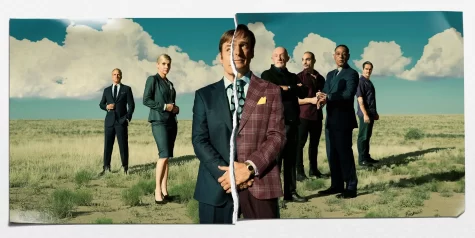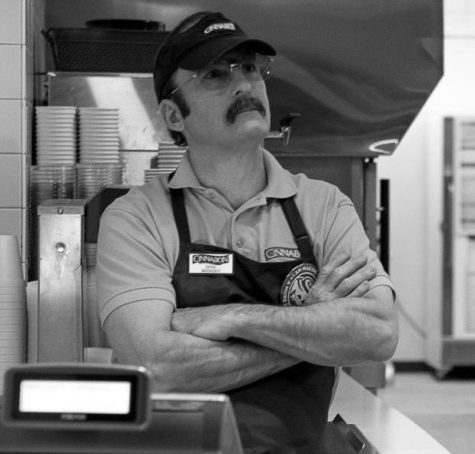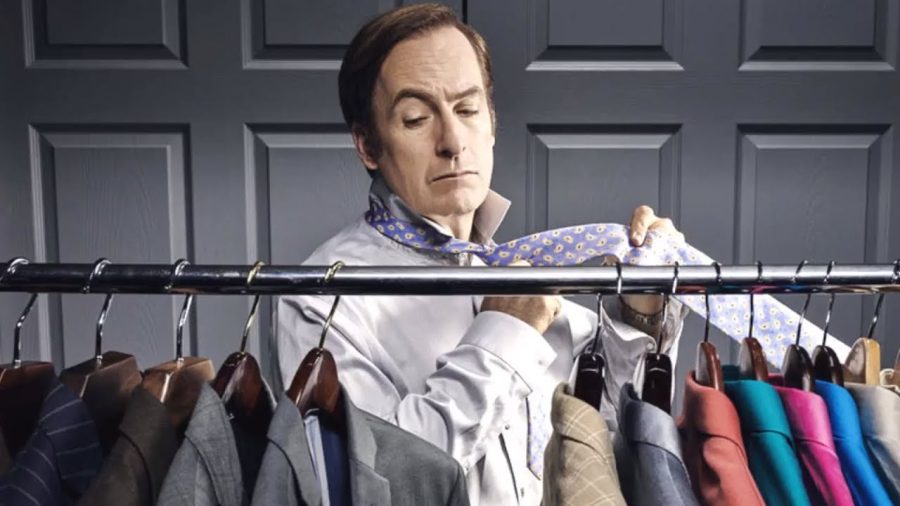Better Call Saul: A Masterclass In Storytelling
October 27, 2022
Better Call Saul is a tale of love and abuse of the law, bullets & bloodshed, and dynamic relationships. And although it may be unassuming at the start, the law is no joke here, and paired with the cartel, it’s worlds colliding with explosive reactions.

The show is a 2015 AMC show that is a direct spin off of Breaking Bad. Both are created by Vince Gilligan and co-created by Peter Gould. The show is a prequel of Breaking Bad, and follows the story of Saul Goodman, otherwise known as Jimmy McGill. He is an up and coming lawyer in Albuquerque, New Mexico, and goes into the world of law coming from a life of crime, and conning.
BCS had a run of 6 seasons, and each one is more captivating than the next. It has a unique style and flair, with its many montages, twists, interesting and compelling characters, and world building.
As with the former BB, BCS never strays away from character growth and development. But this time around it’s amplified more than ever, as BCS is a character study more than anything else. Subversion is a key tool of Gilligan’s, as oftentimes characters do not mean what they say, or say how they really feel about something, it’s about facial expressions, and body language.
Lying is the crux of most characters as a whole. There are no heroes, and everyone is a villain. It’s bad guys, and worse guys. But in BCS, this philosophy is more grounded, but tension builds and builds with its slower, more methodical pace. This builds up to huge mind blowing revelations and conclusions to characters arcs, and certain plot threads.

The main components of BCS that allowed it to have a longer run than BB is its characters, and world building. The show begins in the aftermath of BB, following Saul in his new life as Gene Takovic, relocated in Omaha, Nebraska. This was done to escape the authorities after the events of BB. Straight away the show already has a striking difference in tone, and appearance. The Gene scenes are shot in black and white, and melancholic 50s & 60s music covers the bleak, and unassuming life of Gene.
The biggest and one of the most applaudable aspects of the show, is the differentiation of Saul, Jimmy, and Gene. They are all coded to be different people. Saul is the conning and criminal lawyer he is in late BCS and BB, Jimmy is honest, earnest, and caring. But he also has his conning side, Slippin’ Jimmy, which is in short, an early version of what Saul would become. And Gene is the aftermath of all these personas, a bleak, melancholic, and sad man, reliving his past through VHS tapes and thinking about the good ol’ days, going about his life managing a Cinnabon.
Tonally, BCS starts out with a bang. Viewers would already be familiar with Saul from BB, but as said previously, Jimmy is an entirely different person. We see his humble beginnings, conning and getting into trouble, and being a small and unassuming lawyer operating out of the back of a Vietnamese salon…
…Until the cartel gets involved. Within the first few episodes the direction of the show goes from 0 to 100, with Jimmy being captured and taken out to the desert while having his life threatened. Jimmy’s most favorable and iconic trait is his way with people, and how he can speak and persuade them with his suave personality and language. He’s able to subdue Tuco Salamanca, one of the main antagonists in early BB quite easily, while at the same time having a gun to his head. His skills are masterful, and are what he hinges on for much of the series as a whole.
The cartel becomes a key and integral aspect of the show, as the show splits between both sides, being sort of the A & B plots of each episode. Some are focused mainly on the cartel, and some are focused on the lawyer side of things. There are many new and returning favorites, including Mike, Gus, the new Nacho Varga, the return of Tuco, etc.
Throughout the overarching story, there are many characters that come and go. From Kim and Jimmy sharing a cigarette in the beginning, to the conflicts with Jimmy’s brother, Chuck, and his associate Howard Hamlin, the show barely has any low moments. Many moments and themes are reprised, and everything all comes back together in the end. The show is overall crafted masterfully, and should be viewed as a prime example of how storytelling, cinematography, writing, character development, and world building can be. It is in a league of its own, and deserves to be held in the regard and esteem it has, and then some.


